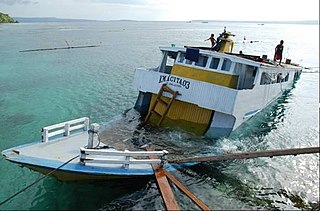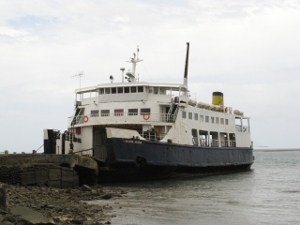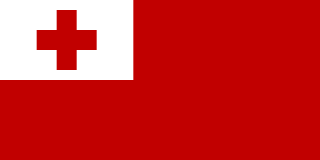
Capsizing or keeling over occurs when a boat or ship is turned on its side or it is upside down in the water. The act of reversing a capsized vessel is called righting.

MV Le Joola was a Senegalese government-owned roll-on/roll-off ferry that capsized off the coast of The Gambia on 26 September 2002, with 1,863 deaths and 64 survivors. It is thought to be the second-worst non-military disaster in maritime history.
MV Skagit was a Skagit Kalama-class passenger ferry originally operated by Washington State Ferries (WSF) from 1989–2009 and then in Tanzania until her sinking in Zanzibar in July 2012.

The MS al-Salam Boccaccio 98 was an Egyptian Ro/Ro passenger ferry, operated by El Salam Maritime Transport, that sank on 3 February 2006 in the Red Sea en route from Duba, Saudi Arabia, to Safaga in southern Egypt.

MV Princess of the Stars was a ferry owned by Filipino shipping company Sulpicio Lines. She capsized on June 21, 2008, off the coast of San Fernando, Romblon, at the height of Typhoon Fengshen, which passed directly over Romblon as a Category 2 storm.

The sinking of MV Teratai Prima occurred on January 11, 2009, around 04:00 local time when a ferry carrying more than 300 people capsized in the Makassar Strait off West Sulawesi, Survivors stated that the ferry had been slammed by 4-metre (13 ft) waves twice. The first one hit so hard that the ship became unbalanced, before another wave hit from a different direction and sank the vessel.

The 2009 Sierra Leone ferry accident occurred on 8 September 2009 off the coast of Sierra Leone, when a wooden Teh Teh ferry travelling from Shenge village to Tombo sank during a storm. At least 90 people to date have been confirmed dead, and over 100 others have been listed as "missing". So far, only 39 survivors have been rescued. Several of the passengers were children who had been on holiday, though the official passenger manifest did not include them. An attempted rescue operation ended on 11 September. The sinking is the worst such accident in Sierra Leone since 2002, when a boatful of refugees capsized. The Xinhua News Agency in China has likened the disaster to other major marine accidents in recent years.

The sinking of MV Dumai Express 10 occurred on the morning of 22 November 2009 when a ferry carrying more than 300 people sank near the island of Iyu Kecil in Karimun Regency, Riau Islands during bad weather. Eyewitnesses reported that massive waves had struck the ferry repeatedly, causing the starboard side of the ship to crack. Subsequently, a considerable amount of water poured into the deck. On 09:55 a.m, the ferry was fully submerged.

On 10 September 2011, MV Spice Islander I, a passenger ferry carrying over 2,000 passengers, sank off the coast of Zanzibar. The ferry was travelling between Unguja and Pemba, two islands off the coast of mainland Tanzania, when it capsized. Early estimates put the death toll at around 200, but a report published by the Tanzanian government in January 2012 claimed that over 1,500 people had been killed.

MV Rabaul Queen was a passenger ferry owned by the Papua New Guinea company Rabaul Shipping. The ship, built in Japan in 1983, operated on short runs in that country, before being brought to Papua New Guinea in 1998 and plying a regular weekly route between Kimbe, the capital of West New Britain, and Lae, the capital of the mainland province of Morobe.

The sinking of MVSewol, also referred to as the Sewol Ferry Disaster, occurred on the morning of 16 April 2014, when the passenger/ro-ro ferry was en route from Incheon towards Jeju in South Korea. The South Korean ferry sank while carrying 476 people, mostly secondary school students from Danwon High School. The 6,825-ton vessel sent a distress signal from about 2.7 kilometres (1.7 mi) north of Byeongpungdo at 08:58 Korea Standard Time. In total, 304 passengers and crew members died in the disaster. Of the approximately 172 survivors, more than half were rescued by fishing boats and other commercial vessels that arrived at the scene approximately 40 minutes after the South Korean coast guard.
On 15 May 2014, the double-decker ferry MV Miraj-4 capsized in the Meghna River, 50 kilometres (31 mi) southeast of Dhaka, Bangladesh. Between 150 and 200 people were on board at the time, of whom about 75 survived. As of 17 May, the official death toll stood at 54 with an unknown number of people missing.

The MV Butiraoi was a 17.5-metre (57 ft) wooden catamaran that operated as a ferry in Kiribati. On 18 January 2018, it left the island of Nonouti carrying 88 passengers. Bound for Betio, the ferry was planned to make the 240-kilometre (150 mi) voyage in two days. According to survivors the overloaded ferry broke in half and sank.

The sinking of MV Marina Baru 2B occurred on the noon of 19 December 2015 when a high speed vessel carrying 112 passengers and crews sank off the coast of Bone, South Sulawesi in inclement weather condition. A 9 day search and rescue operation, conducted by authorities, successfully rescued 45 survivors and recovered 65 bodies from the sea. 12 people were declared as missing and presumed dead.

MV Nyerere is a Tanzanian ferry that capsized on 20 September 2018 while travelling between the islands of Ukerewe and Ukara on Lake Victoria. The Tanzanian government have declared that 228 people died as a result of the capsizing while 41 could be rescued. The capsized ferry was successfully righted, retrieved and unloaded more than one week after the disaster.

The sinking of MV Wahai Star occurred on the night of 10 July 2007 when a speedboat tugged by the ferry accidentally crashed onto the stern of the ferry, resulting in a major leak on the stern. On the following days, rescuers managed to save 43 people, while 16 bodies were recovered on the area of the sinking.

The sinking of MV Acita 03 occurred on the night of 18 October 2007 when a ferry carrying 174 passengers and crews accidentally capsized during its docking in Baubau, Southeast Sulawesi. 134 passengers and crews survived the disaster while 30 passengers and 1 crew member lost their lives. 9 people were listed as missing and presumed dead.





















